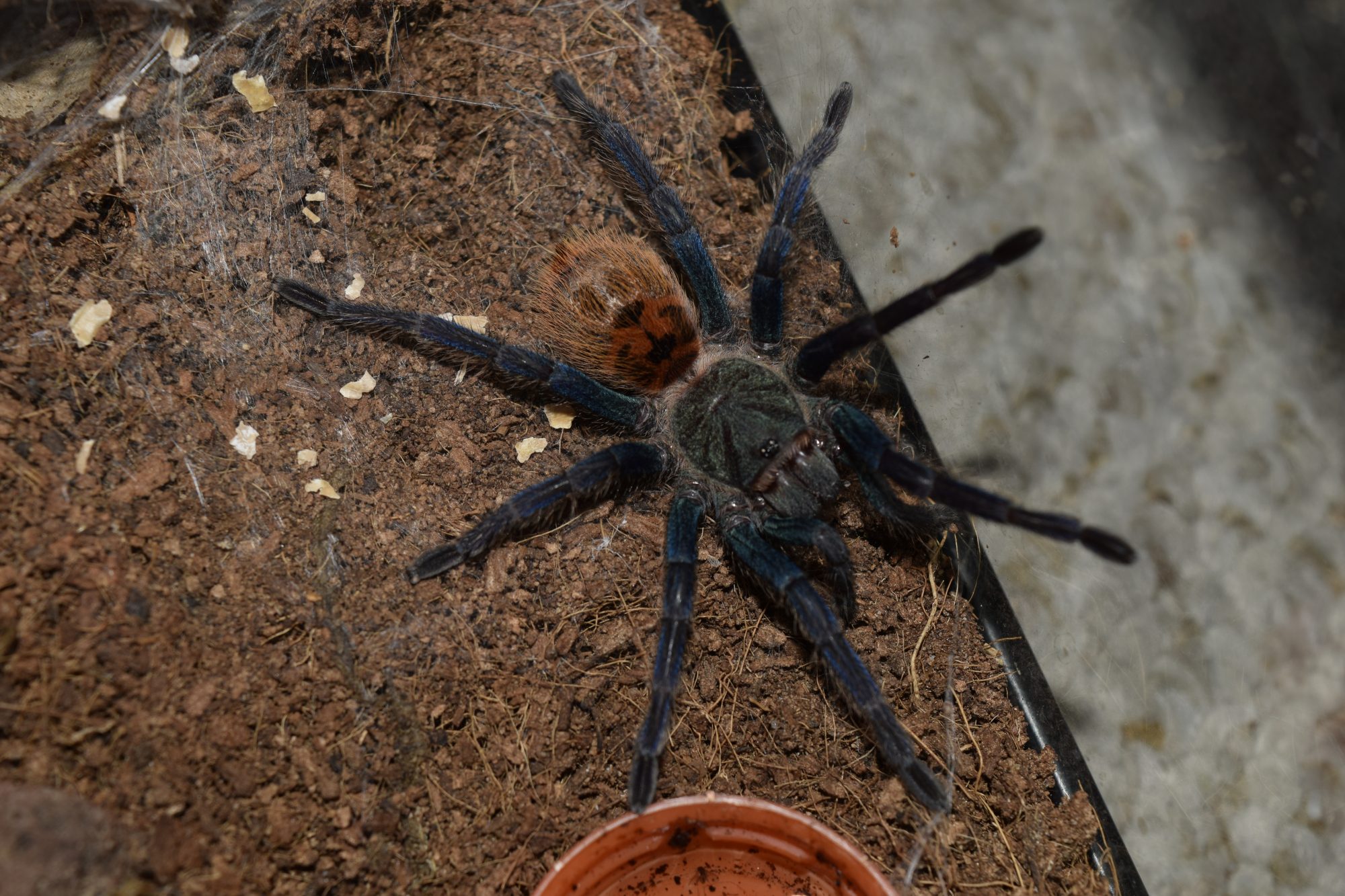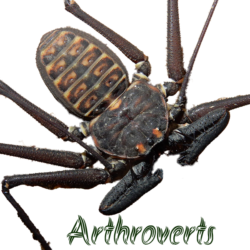Hello all, it’s been a minute!
A full life, website issues, draft posts that I revise endlessly…c’est la vie. But all that’s to say, today I am super excited to share an interview with Dr. Derek Hennen!
Dr. Hennen has studied millipedes, more specifically American xystodesmids, polydesmids, and platydesmids, extensively, having written a complete field guide to the millipedes of Ohio, contributing to the description of the stunning Apheloria polychroma pictured here, and perhaps most famously, naming a millipede after Taylor Swift!
Amongst all this work however, Dr. Hennen is also involved in science communication, appearing on several podcasts and YouTube channels to share about the fascinating field of myriapodology. You can learn more about all of this, as well as his publications and his blog (check out the post on Berlese-Tullgren funnels!), on his website. He is also the world’s no. 2 overall identifier for millipedes on iNaturalist!
To the interview!
Arthroverts: How did you become interested in pursuing myriapodology professionally?
Derek Hennen: It was completely random! When I was an undergraduate student at Marietta College, I had the opportunity to attend a millipede and centipede identification workshop at the Edge of Appalachia Preserve in West Union, Ohio. It was taught by Dr. Bill Shear and was my first introduction to the world of myriapods. I was totally hooked from then on because their biology was fascinating. Plus, they needed a lot of taxonomic work still, and I could find them in pretty much any patch of forest that was nearby.
A: What is it about millipedes specifically that interests you?
DH: Millipedes are a group of animals that I never thought about growing up, so maybe the fact that I knew nothing about them prior to that identification workshop made me want to make up for lost time. Some are very colorful and smell like cherries, while others have muted colors and aren’t very interesting to look at, but have speciated tremendously. With millipedes, there’s always something new to discover and they’re easy to find in a forest. I like that they’re easy to find with simple collecting methods, and people have likely run into one at some point. Many species are endemic to small areas, which is neat from a natural history perspective. Having a species near where you live that doesn’t live anywhere else is really cool, and it’s a great way to connect with your local nature.
A: What is one thing you want people to know about myriapodology?
DH: Now is a great time to get interested in myriapodology! With the advent of websites like iNaturalist, it’s much easier to get a basic grasp of the group’s taxonomy and to see what species might live near you. There are also more identification resources available now (such as my Millipedes of Ohio Field Guide), which make identifying your local species much more straightforward than having to comb through the primary scientific literature.
A: As one of the top millipede identifiers on iNaturalist, what is one thing you wish more people would do (or not do) when sharing millipede observations?
DH: I wish more people would make sure to take in-focus photos of their millipedes from close up. Oftentimes, submitted observations are taken from far away and are blurry, which makes identification difficult. I think people are a bit scared to get too close, but millipedes are harmless and won’t mind if you get in close to take your photos! A good photo from above the millipede and also one from the side are very useful for identification purposes.
A: What is your favorite part of the research process? Why?
DH: Getting out into the woods and collecting specimens! The millipedes and centipedes I study usually live in nice habitats like forests and occur in the leaf litter, under logs, and near streams, so my field collecting often takes place in beautiful spots. I enjoy wandering through the woods and seeing what I can find—you never know what you’ll get each time you go out, which is a small thrill.
A: Do you have a favorite species/genus/family? Completely understandable if this can’t be answered ;).
DH: How can I choose a favorite child? I like the families Xystodesmidae and Parajulidae, both of which are common in eastern North America. When pressed, I usually tell people that my favorite species is Semionellus placidus, the salmon cherry millipede, because that’s the species that sealed my choice to study millipedes. I found it at night using a UV flashlight and it glowed a beautiful blue-green color, it was just astounding. It blew my mind and I decided “okay, this is what I want to study.”
A: What can amateur invertebrate enthusiasts do to aid myriapodological research?
DH: Submitting observations on iNaturalist can be helpful because sometimes that’s how myriapod scientists can find rare species, or even unexpected species in new places. The best thing that invertebrate enthusiasts can do is to work to protect natural habitat. The number one threat to species is habitat loss, so preserving the natural spaces we have is very helpful.
A: How can invertebrate enthusiasts help with the conservation of millipedes, especially cryptic endemics like many xystodesmids?
DH: A big way to help is to be ambassadors for invertebrates like cherry millipedes. Larger animals like mammals and birds receive a lot of conservation funding, so championing lesser-known animals like invertebrates and getting them into the public consciousness is a good way forward. In the past decade, we’ve seen increased funding and recognition for invertebrates like native bees, and I think we can do the same for the cherry millipedes.
A: As you know, I come from a background of culturing various species in captivity. What do you think about attempting to unravel the life histories of some of these cryptic species in captivity?
DH: I think captive rearing can be very useful for studying the life history of cryptic species. For my taxonomic research, I often reared juvenile millipedes to adulthood so I could identify them to species and had great results from it. There’s a history of captive rearing in myriapodology to study how species’ morphology and physiology changes as they grow because captive rearing is often the only way to study these changes.
A: Do you have any tips or advice for people wanting to pursue myriapodology professionally?
DH: Get acquainted with the scientific literature! If you’re interested in taxonomy, you’ll be reading a lot of old papers to learn how species are described, and many species have only been collected a few times. There’s a lot of leg work to be done, but it’s rewarding. Most professional myriapodologists work in academic settings, so if you’re not interested in academia but still want to pursue myriapodology, you may have a more difficult time finding a government or private sector job that involves myriapods. If you pursue graduate school, make sure to advocate for yourself and build a supportive friend group to get you through it.
A: Lastly, any sneak-peeks on what’s in the pipeline for you?
DH: I’ve been sampling for myriapods on a nearby mountain for about the past year with leaf litter collection methods, which I’m planning to write up soon. The most difficult part is knowing when to stop collecting and get to writing, but I’m excited at the prospect. I planned this as a “place-based study” to see how many myriapods I could collect from a forest, and so far I’ve identified about 50 species, which is pretty good! What surprised me the most was how productive collecting myriapods in the late fall and throughout winter can be. I’ve collected some species during the cooler months that you don’t ever see active in the spring or summer, so if you’re not out looking when it’s chilly, you’re probably missing some species. That’s good news because now I have something to do during the winter!
A big thank you to Dr. Hennen for sharing his experience and advice, and on behalf of amateur millipede enthusiasts everywhere we wish you the best of luck with all your endeavours!
Dr. Hennen can be reached at his website here or via Instagram here.
Also a thank you to Connor Smotzer for providing the banner photo of the Apheloria cf. polychroma!
Till next time all!
Thanks,
Arthroverts


